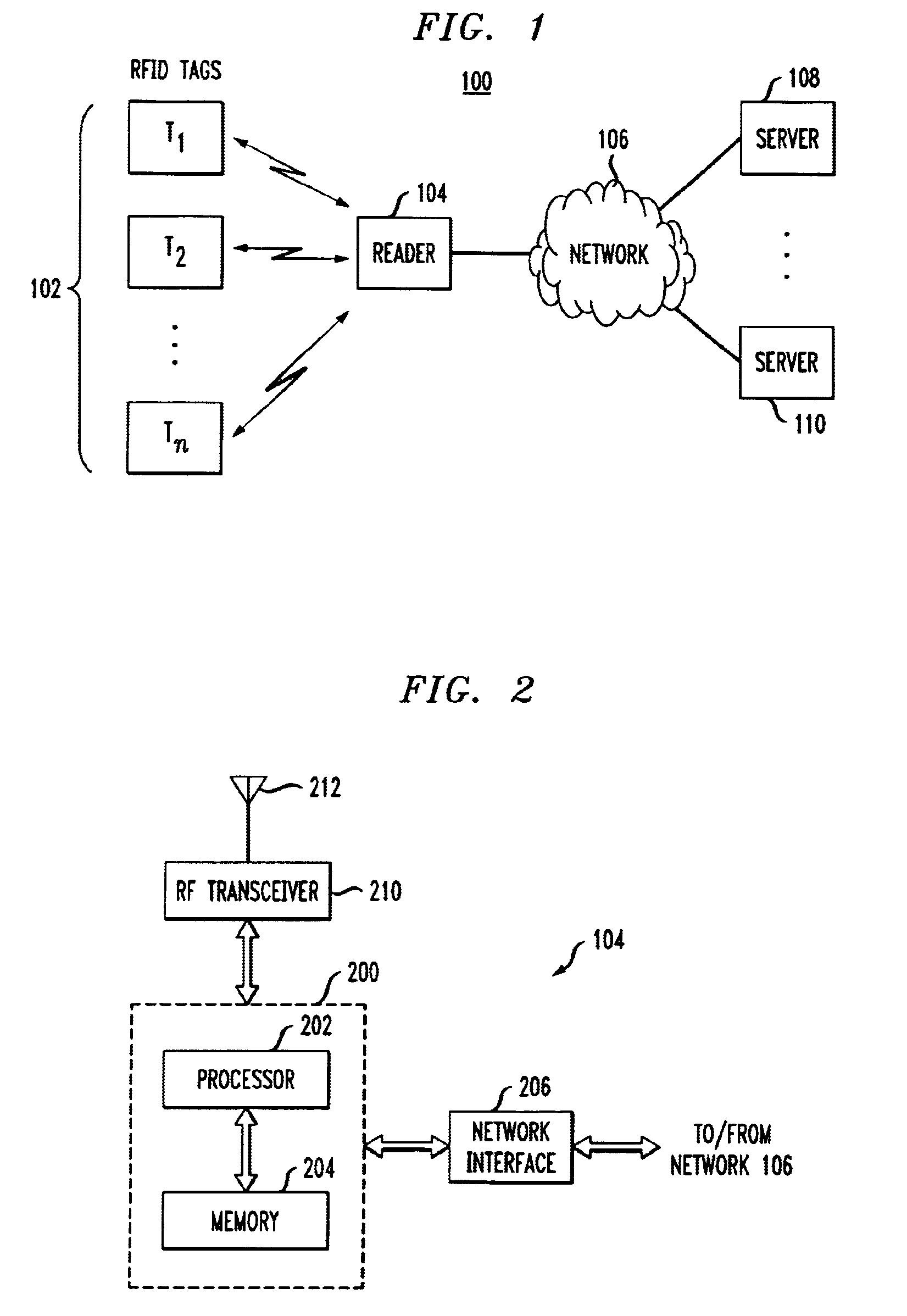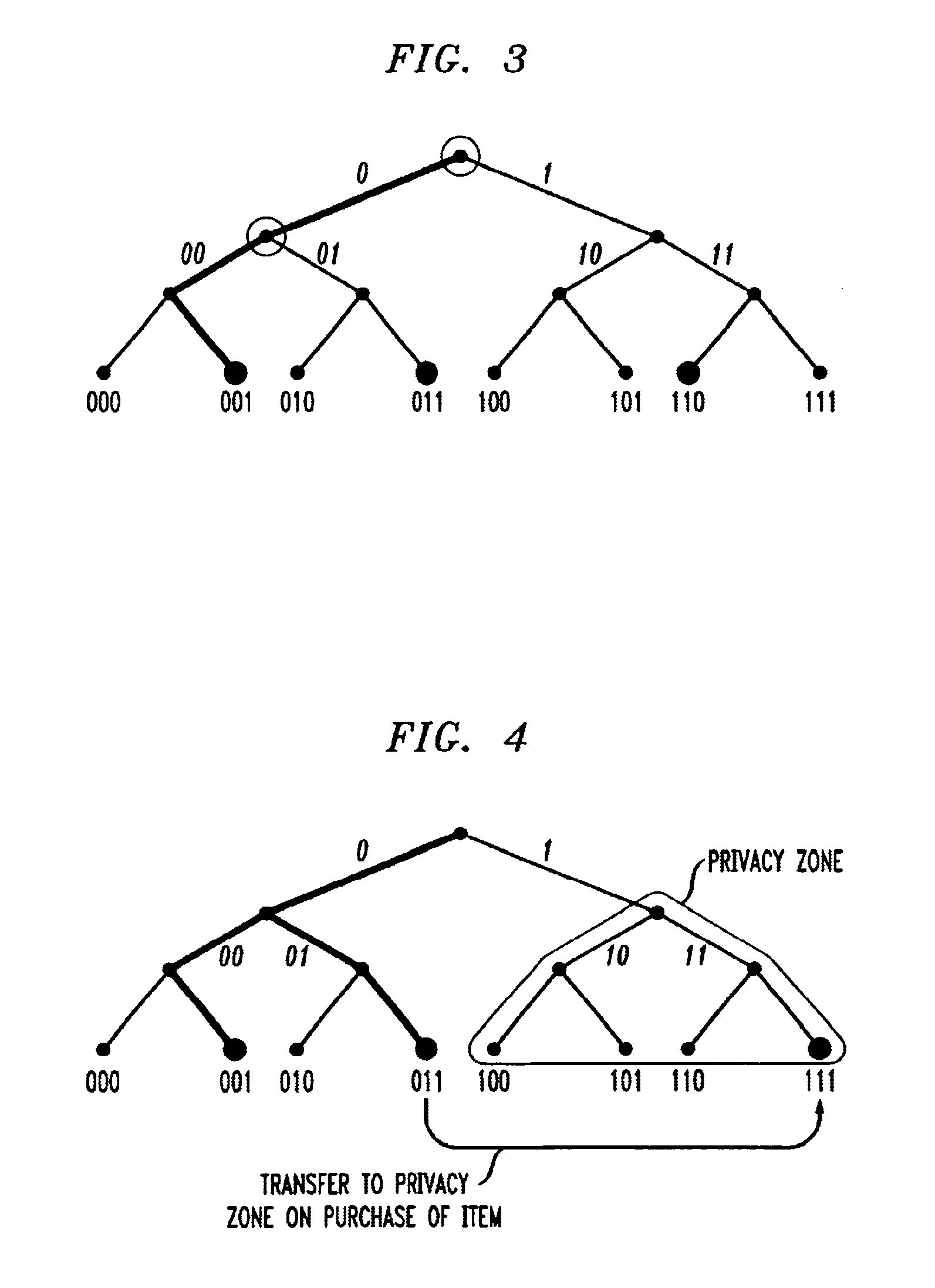Method and apparatus for selective blocking of radio frequency identification devices
a radio frequency identification and selective blocking technology, applied in the field of radio frequency identification (rfid) tags, can solve the problems of unworkable simple measures like kill commands, unsatisfactory privacy enforcement, and potential widespread threat to consumer privacy, and achieve the effect of enhancing consumer privacy, cost-effectiveness, and reducing the effectiveness of the device as a tracking mechanism
- Summary
- Abstract
- Description
- Claims
- Application Information
AI Technical Summary
Benefits of technology
Problems solved by technology
Method used
Image
Examples
example 1
[0082]Privateway Supermarkets makes use of selective blocker tags whose privacy zone consists of all IDs with a leading ‘1’ bit. Packages in Privateway Supermarkets each bear an RFID tag with a unique ID used for purposes of inventory control. As initially programmed, and while an item is inside the supermarket or its warehouses, the tag ID carries a leading ‘0’ bit. At this point, the selective blocker tags do not disrupt the ordinary reading of other tags.
[0083]When the RFID tag reader at a cash register scans an item for purchase by a customer, it also transmits a tag-specific key to the RFID tag on the item, causing the leading bit in the tag ID to flip to a ‘1’. The key should be secret so as to prevent an attacker from transferring tag IDs arbitrarily into the privacy zone. Privateway Supermarkets also provides its customers with free selective blocker tags. These may be available, for example, embedded in shopping bags at registers, as stickers to be placed on items, or using...
example 2
[0089]Suppose that the first two bits of tag IDs specify a desired privacy zone ranging from zero to three. Alice might carry a zone-one selective blocker tag in her wristwatch. So as to protect her clothing and personal appliances from scrutiny, all of these items would then be marked with a zone-one prefix.
[0090]On the other hand, Alice might like to be able to handle groceries without blocking their tags. In this case, on checkout, her grocery items could be marked with a zone-two prefix, while privacy stickers for these items carry zone-two selective blocker tags. Thus, when the stickers are removed, Alice can handle them without her wristwatch blocker tag interfering with the reading process. Alice might choose, on the other hand, for her automobile to implement the strongest level of protection, blocking RFID tag reading in all four zones.
example 3
[0091]As indicated previously, proposals have been made to embed RFID tags in currency. Using the techniques of the invention, IDs for these tags might be relegated to a special privacy zone for currency.
[0092]To protect the privacy of consumers, then, wallets could be equipped with embedded selective blocker tags or with credit-card-like devices bearing selective blocker tags.
[0093]The presence of a currency-zone blocker tag would be easily detectable, as will be described below. Thus, in sensitive locations like airports, law-enforcement officials could take the approach of temporarily sequestering wallets in Faraday cages during security checks. They could then detect the presence of suspicious currency-zone blocker tags. In the absence of such tags, or following their identification and removal, it would be possible to monitor large and suspicious currency flows. The particular policies are obviously a subject for debate. However, the selective blocker tags of the present invent...
PUM
 Login to View More
Login to View More Abstract
Description
Claims
Application Information
 Login to View More
Login to View More - R&D
- Intellectual Property
- Life Sciences
- Materials
- Tech Scout
- Unparalleled Data Quality
- Higher Quality Content
- 60% Fewer Hallucinations
Browse by: Latest US Patents, China's latest patents, Technical Efficacy Thesaurus, Application Domain, Technology Topic, Popular Technical Reports.
© 2025 PatSnap. All rights reserved.Legal|Privacy policy|Modern Slavery Act Transparency Statement|Sitemap|About US| Contact US: help@patsnap.com



